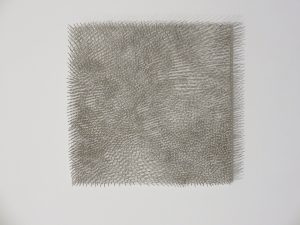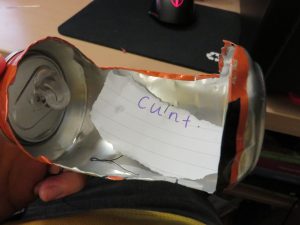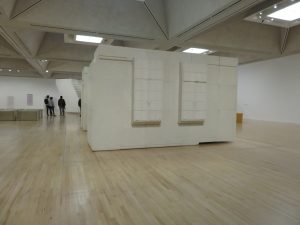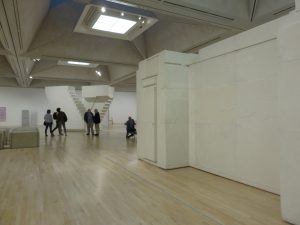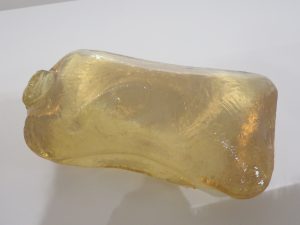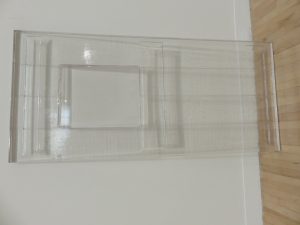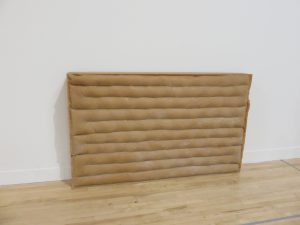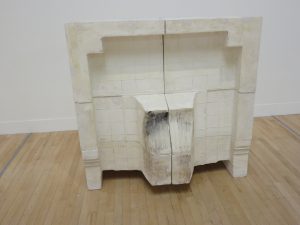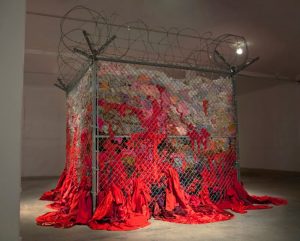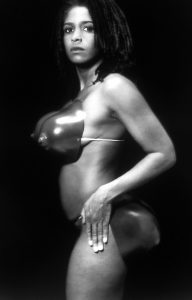The work of Jenny Holzer has already overcome the concerns raised by the idea of changing work to fit scale – moving from small stickers on parking meters to big enough to out size Blenheim Palace. Holzer uses a range of technology to ameliorate the transformation. Small slogans appear in a series of images on stickers, posters and t-shirts using printing techniques. Holzer uses Electronic signs LED that circulate the maxims from her truism series. She has used LED in her work since 1982. The methods of presenting the aphorism are generally vehicles used for public information. Holzer recognises that and subverts that to call attention to her art. The texts are often subversive and denouncing of power and inequality which also speak of importance and size. The biggest of the signs are projected by lights onto the facade of the palace at night. This is such a powerful and moving sight. the maxims are so powerful and moving. the method of showing the message so large it cannot be ignored
Category Archives: Fine Art
Task 7
Leo Steinberg (b. 1920) from Other Criteria, discusses ‘relating Modernist work to a changing continuum of self-reference and representation of the world going back to the Renaissance.’ This text analysing Steinberg’s writing, claims that Other Criteria ‘was received as a powerful counter to what was seen in the early 1970s as an increasingly barren and entrenched formalist orthodoxy’, meaning that he challenged what was considered normative in the 1970s and provided new principles to work by. Contemporary characteristics of art which often are the factors determining the era in which it belongs, are commonly defined by how much they push the boundaries of what is considered of its time.
Steinberg’s essays are further examined and built upon with descriptions of how this perceptive art theory is translated into practical methods of artistic manipulation such as ‘color economies’, ‘proportional attenuation’, and ‘shifting reality levels’; or ‘the “recall to art” may be engineered by the subject matter itself through devices such as internal spectators, the juxtaposition of windows with framed paintings, or mirrors filled with reflections’ in a phrase of ‘art drawing attention to art’.
The text later discusses the idea of a ‘Flatbed Picture Plane’ in order to describe the ‘pictorial surface whose angulation with respect to the human posture is the precondition of its changed content’ -or more commonly- artwork displayed in the traditional format parallel to the observer. It is common when observing artwork through the ages -or simply the view of one’s surroundings- to witness a canvas or frame hung on a gallery wall, a sculpture surfacing from the ground, or a landscape view from a window. Here, the idea is postulated that -to not conform towards custom, or to remove any personified association within the art piece, curation should be experimented from more unorthodox perspectives, as the presentation of the artwork becomes part of the art itself.
Similarly, in The Yale Lecture by Richard Serra (b. 1939), the idea of site-specificity is challenged in the simple phrase ‘You can’t build work in one context and indiscriminately place it in another.’ In this transcription of Serra’s Lecture, the issue of curation and space is repeatedly discussed in order to persuade the listeners to consider the context of the landscape in which art is both created and presented. For art to truly be enjoyed and connected with by its audience (if that is the purpose of its outcome) the energy from its surroundings and the nature of its appearance should be measured and foreseen by the creator(s) to express the idea in which they created, rather than having external elements influence the narrative and manipulate the message (or lack of) which the art is portraying. This is exemplified in Le Corbusier’s letter (1932) ‘if the Sistine Chapel’s wall and ceiling were intended to be preserved a form, they should not have been painted with frescoes… someone wanted to remove forever their original architectural character and create something else’. Though this premise may be the intention of the work itself, Le Corbusier argues the importance of being aware of Art’s context.
As individuals born in 1939 and 1920, Serra and Steinberg’s life experience precedes the Contemporary movement and explore the shift from Modernism to Post-modernism. At this artistic turning-point of the 20th Century, both have first-hand knowledge and understanding of the zeitgeist, and the way in which factors within politics and global events such as the Second World War influenced the production of artwork. Therefore, their experience with contextual understanding and drastic change is valued in their text.
Blog 6
For the task given, we were told to create or evolve an art practice. As a practicing artist whom enjoys working in textiles, I decided to use stitching and embroidery as a starting point from which to evolve my chosen practice. As a physical object, subject to manipulation, thread, wool, and fabrics are interesting to work with and are commonly used together. However, I was interested in expanding the ways in which we use stitching to also cover items we may not typically associate it with.
On top of this I decided to also experiment with incorporating words into artwork. For example: Why do we, as humans, label writing and drawing as two separate things? If drawing -in reality- is mark-making, why isn’t writing under that same label? What differs the two?
Although, there are plenty of artists who have pushed traditional concepts of separating drawing/ painting/ art in general from writing by bringing them together, I wished to combine this concept with the physicality of the previous experiment. Thus, stitching words into Everyday objects and materials.
The next step was deciding upon the word(s) to stitch. Conceptual art, in any artistic movement often implies a theme of pushing the boundaries of what is currently available -looking into the future. A current battle within the art world includes the question: ‘why spend your whole career (or parts of it) looking at/ working on the same things. Artists like Ad Reinhardt produce very similar pieces over time and from my perspective, this is in protest of that very question. Following this, I made the decision to use one word continuously throughout my experiments upon different surfaces.
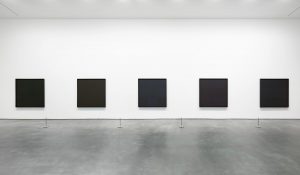
Ad Reinhardt photo from exhibition – David Zwirner https://www.davidzwirner.com/exhibitions/ad-reinhardt
The final decision before beginning to work was which word I should use, to which I had a very easy discovery. The most taboo, powerful expletives of protest ‘cunt’ seemed like the obvious word to use. As something commonly avoided in conversation, publicising it seemed like the best way to explore text and protest in one continuous outcome.
This is Gunther Ueker’s 1964 piece, White Field which inspired my experimentation with needles

Task 12
For this task I decided to choose a large-scale piece of work called ‘Water Painting’ 1999 by Gary Hume. As it is small on the screen, I tried to imagine what it would look like in the flesh, being 3050 x 2440 x 21 mm.
Moving on, I imagined what the image would look like in real life, but much smaller in scale, such as postcard size. I think the figures would become almost unrecognizable and merge together on the page. This may actually be quite interesting and may even keep the viewer looking for longer as it creates intrigue as you have to unravel the image yourself.
In order to facilitate the transformation, I would place the image in a row with the rest the series of Water Paintings, and scaling them all down so they were all the same size. I would also make the lines of the drawings thinner. This is so that when the image is scaled down, they wouldn’t become too thick and messy, I wouldn’t want the image to lose its primary characteristics of being a simple line drawing. Furthermore, images that are made smaller, tend to lose their main appeal of being big and bold and eye catching. Thus, in order to refrain from losing this trait, I would intensify the colour palette, otherwise the image may look quite dull and unappealing.
On the other hand, if I was to make the image much bigger, billboard size, the lines would have to be made much thicker and brighter. This is so that they do not become lost within the colour of the background which could happen if it was looked at from afar. I think this image in particular would benefit from being much larger as it would almost be like the figures were looking down on society.
Task 12
This painting is 80x100cm and was painted using a palette knife and acrylic paint. Even though it was one of the biggest canvases I worked on, I believe it isn’t big enough. The goal of this painting was to make the viewer feel like they could enter the scene, like they were surrounded by a forest. In order to achieve this connection between the painting and the viewer, the painting must be as big as possible. It could even be painted straight on a gallery wall, as there really is no need for a canvas. Painting it on a larger scale will make room for more detail that could be added to the trees, to make them look more realistic. However I would like to keep the texture that the palette knives provided, since it adds realness to the painting. The increase in scale would also mean more colours could be added onto the painting, so that when it is viewed from up close, it would have an impressionistic style. The focal colours (burgundy, red, orange, yellow, purple) would remain the same though, since I want to portray a glowing autumnal scene.
Task 5
Seeing a large-scale sculpt such as ‘Ghost’ in person at her Tate exhibition, was an incredibly valuable experience. Sculpture and installation are mediums in particular, demand the experience and exhibition space surrounding it to achieve what, arguably, the purpose of exhibitions aim. Looking at objects presented 2-Dimensionally does not exert the same level of impact upon viewers and therefore exhibits are treasured memories for the perceivers.
‘Ghost’ by Rachel Whiteread challenges the native perception of a living room being structurally sound, representative of the owner’s character, and comforting. This mix of architecture and sculptural installation art presents interior space in a way we don’t typically recognise, despite it being a fundamental part of our existence. By the technique of inverted space, Whiteread creates life-sized casts presenting a physical, ‘anatomical’ (If walls could talk: An interview with Rachel Whiteread, 2002) representation of space.
Through this space-containing practice, Time is also captured in a state of frozen-ness, holding memories of the individual who may have lived in the mould of this cast. Ironically through preserving the building’s character, it is subsequently lost within the concrete enclosure, and only the physical structure is left to be seen. Thus further expanding the viewpoint that there is both an interior and exterior, an implied persona, or a side to which no-one but those of the creator’s choosing can see.
Reflecting upon this exhibition, I would like to further it by reading into the concepts of Time, Space, and The Everyday and have begun my research into the Whitechapel Gallery Texts on these.
If walls could talk: An interview with Rachel Whiteread (2002) Available at: http://pastexhibitions.guggenheim.org/whiteread/interview2.html (Accessed 6 February 2017)
Task 4
Being a fan of Rachel Whiteread’s sculptures using negative space to translate the everyday into lifeless casts of what the item once was, I recently visited Tate Britain to see it in person. By being able to perceive space in this format, the viewers (sub)consciously become more aware of their surroundings. The way in which this exhibition was curated, it allowed each exhibit to be reflected upon in its own time while not entrapping it within the gallery space itself; for example, ‘Ghost’ which was exhibited there, presents the interior of an entire living room space- so the ‘room within a room’ aspect was explored but yet with this curatorial setup, did not become the focal point of the exhibition.
Task 11
I have found many of the Research and Communication Skills tasks quite challenging, particularly task 7 to which we had to summarise, reflect and comment on the relationship between two texts. I think I found this task quite difficult because it was such a vast amount of text which I had to read and understand for myself, which was quite daunting. I learned that I had to be very patient with myself for this task, I had to analyze the script and depict the most important aspects for the essay of 250 words. This skill will help me in the future as I will be better at getting straight to the point in my essays rather than adding irrelevant information.
Many of the tasks, such as task 3 and 9 have made me think more openly towards artist’s work that I may not have normally been interested in. Particularly task 3 to which we had to choose out of 4 images given to us and analyze it. I chose Renée Cox’s Hot-en-tot Venus, 1994 photograph to which I discovered had a very interesting meaning behind it, and the artist herself was a very powerful figure. If it wasn’t for this task, I probably would have never have discovered her work.
The blog has also helped me to become more reflective on my own work as well as when looking at artist’s work which benefits my research for the projects. It benefits me because I tend to discover more about the work than I had before, as I go into more depth in analyzing it. This helps me in my own practice as its good to know how other artists work and what inspires them.
Task 9
The work I have chose is an installation by the artist duo Guerra De La Paz from their exhibition ‘Barbed’. The aesthetic theory of art can be applied as it becomes art through the artists carefully thought out arrangements of the clothes and the composition of the overflowing red shirts at the bottom shows intention as well as its clear isolation from the room by its surrounding barbed fences. As a result the installation produces a non-coincidental experience from its aesthetics despite the fact that it mimics and exaggerates the issues over recycling and overflowing rubbish that persists around the world. The thing it mimics, the issue, does not itself evoke any experience from its aesthetics and thus does not evoke much awareness not being an art piece. It has no distinct appearance that draws peoples interests unless either told of its consequences. Therefore the act of using objects that are subject to the issue of waste to create art is a form of Aesthetics that visualises on a social and economic issue that is very relevant today.
Task 3
For this task on discussing the mise-en-scene of works by Female Artists and the context surrounding them, I chose the ‘Hot-en-tot Venus’ 1994 photograph by Renée Cox depicting her own body as a model to promote “self-love” (Hooks, B. ‘Sisters of the Yam’ -1993). This image represents the ideal body image for black females to try and achieve in order to look attractive. The obvious, faux plastic breasts and buttocks help to communicate the argument that idealised, societal beauty cannot be achieved without falseness.
The monochrome finish allows the portrait to suggest a racial interpretation of the artwork, focusing politically on the duality of life (i.e. Black/White, Female/Male, Gay/Straight). Through breaking the element of the fourth wall, the audience is addressed directly as though communicating the message of society taking action to break down the existing attitudes.
Cox, as a black Jamaican-American artist, brings her political activism into her artwork in order to provoke action in the subjects of Feminism, Gender, Race, and Culture. Therefore, using her art as a platform to promote change and protest within society, Cox pushes the boundaries of what the art can truly be defined as. Questioning whether the image itself is in fact the art, the message it conveys, or the performance of activism encouraged by the piece.
https://en.wikipedia.org/wiki/Renee_Cox

